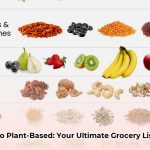Inflammation can sneak up on you, causing all sorts of health problems. But guess what? Delicious Indian food can actually help fight it! This guide is all about discovering the amazing anti-inflammatory power of Indian spices, herbs, and ingredients. We’re not talking about a boring diet here – this is about making tasty, healthy changes that really work. We’ll show you exactly which Indian spices are best for reducing inflammation, how to use them, and even give you some delicious, easy-to-follow meal plans. Learn from recipes, and create a long-lasting healthy eating routine. For more anti-inflammatory recipes, check out this helpful resource: anti-inflammatory recipes. Get ready for a flavorful adventure that’s good for your body and your taste buds!
Anti-Inflammatory Indian Food: A Delicious Path to Wellness
Chronic inflammation can quietly undermine your health, increasing the risk of heart disease, arthritis, and other ailments. But what if the answer to feeling better lies in the vibrant, flavorful world of Indian cuisine? Let’s dive into how anti-inflammatory Indian foods can help you take control of your health. This isn’t about strict diets; it’s about making smart, delicious choices and consuming various essential nutrients.
Supercharged Spices: Your Secret Weapons
Your spice rack is brimming with powerful natural compounds. Turmeric, with its star ingredient curcumin, is a fantastic example. Its bright yellow color adds a beautiful touch to dishes and boasts significant benefits. Ginger, a staple in many cultures, offers a soothing warmth and is known for its properties. Garlic is commonly used in Indian cooking. These aren’t just flavors; they’re nutritional powerhouses that help your body fight inflammation. The best part? Combining them creates an even more potent effect! Think of a turmeric-ginger-garlic paste for your next curry – it’s delicious and beneficial.
Beyond Spices: A Rainbow of Goodness
While spices are stars, the power of Indian food goes far beyond them. Think of leafy greens like spinach, overflowing with antioxidants that combat inflammation. Lentils (dal), a cornerstone of Indian cuisine, are packed with fiber, crucial for gut health and likely playing a role in reducing inflammation. Fruits like berries, mangoes, and pomegranates add not only deliciousness but also valuable vitamins and antioxidants. And let’s not forget healthy fats in nuts and seeds—they’re essential for a balanced diet and contribute to a healthy response. The key is variety. Embrace the colorful bounty of Indian vegetables and fruits for a holistic approach to reducing inflammation.
Building Your Meal Plan: A Flavorful Journey
Ready to put this knowledge to work? Here are a few sample meal plans to get you started. Remember, these are just suggestions; tailor them to your tastes and preferences. Experiment! The beauty of Indian food lies in its endless variations.
Day 1:
- Breakfast: Oatmeal spiced with turmeric and ginger, topped with a sprinkle of almonds.
- Lunch: Hearty lentil soup (dal) brimming with spinach, served with a side of brown rice.
- Dinner: Chicken or vegetable curry (choose your preferred protein) featuring cauliflower and a blend of spices.
Day 2:
- Breakfast: Creamy yogurt with a mix of berries and a sprinkle of chia seeds.
- Lunch: Vegetable biryani, a fragrant rice dish packed with colorful vegetables. Add a simple side salad.
- Dinner: Roasted vegetables tossed with chickpeas and seasoned with cumin. This is an easy meal that’s both tasty and healthy.
Day 3:
- Breakfast: A refreshing smoothie blending mango, spinach, and ginger.
- Lunch: Leftover vegetable biryani—convenient and still delicious!
- Dinner: Tandoori chicken (or paneer for a vegetarian option) served with a side of brown rice.
Remember, the goal is variety. Explore different regional Indian cuisines—each region boasts unique flavors and ingredients that contribute to a diverse and healthy diet. Don’t be afraid to experiment and find what you enjoy most!
Foods to Moderate
While we focus on adding foods, it’s also helpful to understand which foods might contribute to inflammation. Refined sugars, trans fats, and excessive saturated fats, often found in processed foods and sugary drinks, are often associated with increased inflammation. You don’t need to eliminate these entirely, but moderation is key. Focus on making small, gradual changes instead of drastic overhauls. This approach is more sustainable and sets you up for long-term success.
Practical Tips for a Transition to Healthier Eating Habits
Embarking on a dietary shift requires a thoughtful approach. Here are some tips for success:
- Start Gradually: Don’t try to change everything at once. Slowly incorporate more foods into your meals.
- Focus on Adding: Emphasize adding healthy options rather than solely focusing on removing certain foods. This approach is less restrictive and more enjoyable.
- Practice Mindful Eating: Pay attention to your food. Savor each bite, noticing the flavors and textures.
- Consult a Professional: Talk to your doctor or a registered dietitian, especially if you have pre-existing health conditions. They can provide personalized guidance.
This approach isn’t just about fighting inflammation; it’s about embracing a vibrant, flavorful approach to healthy eating. It’s about nourishing your body with delicious food while enhancing your overall well-being. Now, go ahead and enjoy the journey!
How to Create a Personalized Indian Diet Plan
Understanding Inflammation
Inflammation, while a natural response to injury, becomes a problem when it’s chronic. It’s linked to many health issues. Fortunately, diet plays a powerful role in managing it. Indian cuisine, with its abundance of spices and vibrant vegetables, offers a fantastic toolkit.
Nature’s Arsenal
Many Indian ingredients possess properties. Let’s explore some key players:
- Turmeric: The star! Curcumin, its active compound, is a potent anti-inflammatory. Add it to your curries, dals, or even your morning tea.
- Ginger: This versatile root is a common addition to Indian dishes. It soothes the digestive system and possesses benefits.
- Garlic: Another culinary ingredient, garlic adds flavor and a powerful punch.
- Spinach (Palak): Rich in antioxidants, spinach is a nutritional powerhouse, supporting your body’s fight.
- Fenugreek (Methi): This spice is often added to dals and flatbreads. Its properties are well documented.
- Amla (Indian Gooseberry): This tart fruit packs a high dose of Vitamin C and other antioxidants. It’s typically enjoyed as a chutney or juice.
Building Your Plan: A Step-by-Step Guide
Creating your personalized plan involves a thoughtful approach.
Step 1: Assess Your Current Diet. What are your regular meals? What are you already consuming?
Step 2: Identify Areas for Improvement. Are you consuming excessive sugars or unhealthy fats? This step allows you to pinpoint areas needing attention.
Step 3: Incorporate Foods. Start slowly. Add one or two new ingredients each week. Experiment with new recipes.
Step 4: Create a Weekly Meal Plan. Plan your meals ahead of time, incorporating the ingredients you’ve selected. This approach promotes consistency.
Step 5: Listen to Your Body. Pay attention to how different foods make you feel. Adjust your plan accordingly. This is crucial for personalization.
Sample Meal Plan
| Day | Breakfast | Lunch | Dinner |
|---|---|---|---|
| Monday | Turmeric milk with nuts | Palak Paneer with brown rice | Chicken Tikka Masala (low-fat) |
| Tuesday | Oats with ginger and amla | Moong dal cheela | Sambar with brown rice |
| Wednesday | Vegetable stuffed paratha | Aloo Gobi | Fish curry with brown rice |
Things to Minimize
Reduce your intake of:
- Processed foods: These often contain high levels of unhealthy fats, sugar, and salt.
- Sugary drinks: Sodas and juices contain high amounts of added sugar.
- Refined carbohydrates: White bread and pastries can spike blood sugar levels.
- Excessive red meat: Limit your intake of red meat, as it can promote the production of certain compounds that may worsen inflammation.
By making informed food choices based on this information, you can successfully reduce inflammation and boost your overall quality of life.
- Discover Healthy Snacks for Plant-Based Diets: Fuel Your Body Now - November 4, 2025
- Manage Autoimmune Disease with Plant-Based Diets: A Simple Guide - November 3, 2025
- Your Plant-Based Shopping List: A Guide to Sustainable Eating - November 1, 2025










